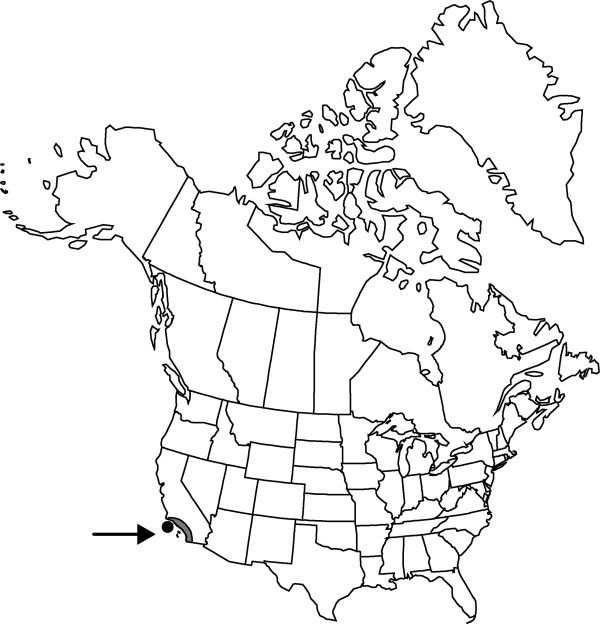Difference between revisions of "Opuntia oricola"
Cac t. Succ. J. (Los Angeles) 36: 163, 3 figs. 1964.
FNA>Volume Importer |
imported>Volume Importer |
||
| (7 intermediate revisions by 2 users not shown) | |||
| Line 16: | Line 16: | ||
}}<!-- | }}<!-- | ||
| − | --><span class="statement" id="st- | + | --><span class="statement" id="st-undefined" data-properties=""><b>Trees </b>or shrubs, spreading, 2–3 m; trunk, when present, to 30 cm. <b>Stem</b> segments not disarticulating, dark green, flattened, subcircular to broadly obovate, 16–25 × 16–19 cm, nearly smooth, glabrous; areoles 8–10 per diagonal across midstem segment, prominent, subcircular, 4.5–5.5 mm, greatly enlarging to 10 mm diam.; wool tan to gray. <b>Spines</b> 5–13 per areole, in most areoles, usually reflexed, translucent yellow, aging red-brown, angular, curved, subulate, the longest 20–25(–50) mm. <b>Glochids</b> in rather dense crescent along adaxial margins, increasing in length toward base, subapical tuft poorly developed, tan, aging brown, to 6 mm. <b>Flowers</b>: inner tepals yellow throughout, 25–40 mm; filaments yellow to orange-yellow; anthers yellow; style red; stigma lobes green or light green. <b>Fruits</b> red to red-purple, pale yellow inside, with seed pulp red, subspheric to barrel-shaped, 37–60 × 30–45 mm, juicy, glabrous, spineless; areoles 23–63. <b>Seeds</b> gray-brown, subcircular to semicircular, 3.5–4 mm diam.; girdle protruding to 0.4 mm. <b>2n</b> = 33 (an abnormal, polyhaploid individual), 66.</span><!-- |
-->{{Treatment/Body | -->{{Treatment/Body | ||
| + | |phenology=Flowering spring (May). | ||
|habitat=Coastal sage scrub, coastal chaparral | |habitat=Coastal sage scrub, coastal chaparral | ||
|elevation=0-500 m | |elevation=0-500 m | ||
|distribution=Calif. (including Channel Islands);Mexico (Baja California). | |distribution=Calif. (including Channel Islands);Mexico (Baja California). | ||
| − | |discussion=<p>Opuntia demissa Griffiths is apparently a hybrid between O. oricola and an unknown taxon (B. D. Parfitt and M. A. Baker 1993), likely to be O. littoralis. The hybrid appears to be rather widespread and blurs distinctions between the putative parents.</p> | + | |discussion=<p><i>Opuntia</i> demissa Griffiths is apparently a hybrid between <i>O. oricola</i> and an unknown taxon (B. D. Parfitt and M. A. Baker 1993), likely to be <i>O. littoralis</i>. The hybrid appears to be rather widespread and blurs distinctions between the putative parents.</p> |
|tables= | |tables= | ||
|references= | |references= | ||
| Line 31: | Line 32: | ||
-->{{#Taxon: | -->{{#Taxon: | ||
name=Opuntia oricola | name=Opuntia oricola | ||
| − | |||
|authority=Philbrick | |authority=Philbrick | ||
|rank=species | |rank=species | ||
| Line 38: | Line 38: | ||
|basionyms= | |basionyms= | ||
|family=Cactaceae | |family=Cactaceae | ||
| + | |phenology=Flowering spring (May). | ||
|habitat=Coastal sage scrub, coastal chaparral | |habitat=Coastal sage scrub, coastal chaparral | ||
|elevation=0-500 m | |elevation=0-500 m | ||
| Line 45: | Line 46: | ||
|publication year=1964 | |publication year=1964 | ||
|special status= | |special status= | ||
| − | |source xml=https:// | + | |source xml=https://bitbucket.org/aafc-mbb/fna-data-curation/src/2e0870ddd59836b60bcf96646a41e87ea5a5943a/coarse_grained_fna_xml/V4/V4_265.xml |
|subfamily=Cactaceae subfam. Opuntioideae | |subfamily=Cactaceae subfam. Opuntioideae | ||
|genus=Opuntia | |genus=Opuntia | ||
|species=Opuntia oricola | |species=Opuntia oricola | ||
| − | |||
| − | |||
| − | |||
| − | |||
| − | |||
| − | |||
| − | |||
| − | |||
| − | |||
| − | |||
| − | |||
| − | |||
| − | |||
| − | |||
| − | |||
| − | |||
| − | |||
| − | |||
| − | |||
| − | |||
| − | |||
| − | |||
| − | |||
| − | |||
| − | |||
| − | |||
| − | |||
| − | |||
| − | |||
| − | |||
| − | |||
| − | |||
| − | |||
| − | |||
| − | |||
| − | |||
| − | |||
| − | |||
| − | |||
| − | |||
| − | |||
| − | |||
| − | |||
| − | |||
| − | |||
| − | |||
| − | |||
| − | |||
| − | |||
| − | |||
| − | |||
| − | |||
}}<!-- | }}<!-- | ||
-->[[Category:Treatment]][[Category:Opuntia]] | -->[[Category:Treatment]][[Category:Opuntia]] | ||
Latest revision as of 21:57, 5 November 2020
Trees or shrubs, spreading, 2–3 m; trunk, when present, to 30 cm. Stem segments not disarticulating, dark green, flattened, subcircular to broadly obovate, 16–25 × 16–19 cm, nearly smooth, glabrous; areoles 8–10 per diagonal across midstem segment, prominent, subcircular, 4.5–5.5 mm, greatly enlarging to 10 mm diam.; wool tan to gray. Spines 5–13 per areole, in most areoles, usually reflexed, translucent yellow, aging red-brown, angular, curved, subulate, the longest 20–25(–50) mm. Glochids in rather dense crescent along adaxial margins, increasing in length toward base, subapical tuft poorly developed, tan, aging brown, to 6 mm. Flowers: inner tepals yellow throughout, 25–40 mm; filaments yellow to orange-yellow; anthers yellow; style red; stigma lobes green or light green. Fruits red to red-purple, pale yellow inside, with seed pulp red, subspheric to barrel-shaped, 37–60 × 30–45 mm, juicy, glabrous, spineless; areoles 23–63. Seeds gray-brown, subcircular to semicircular, 3.5–4 mm diam.; girdle protruding to 0.4 mm. 2n = 33 (an abnormal, polyhaploid individual), 66.
Phenology: Flowering spring (May).
Habitat: Coastal sage scrub, coastal chaparral
Elevation: 0-500 m
Distribution

Calif. (including Channel Islands), Mexico (Baja California).
Discussion
Opuntia demissa Griffiths is apparently a hybrid between O. oricola and an unknown taxon (B. D. Parfitt and M. A. Baker 1993), likely to be O. littoralis. The hybrid appears to be rather widespread and blurs distinctions between the putative parents.
Selected References
None.